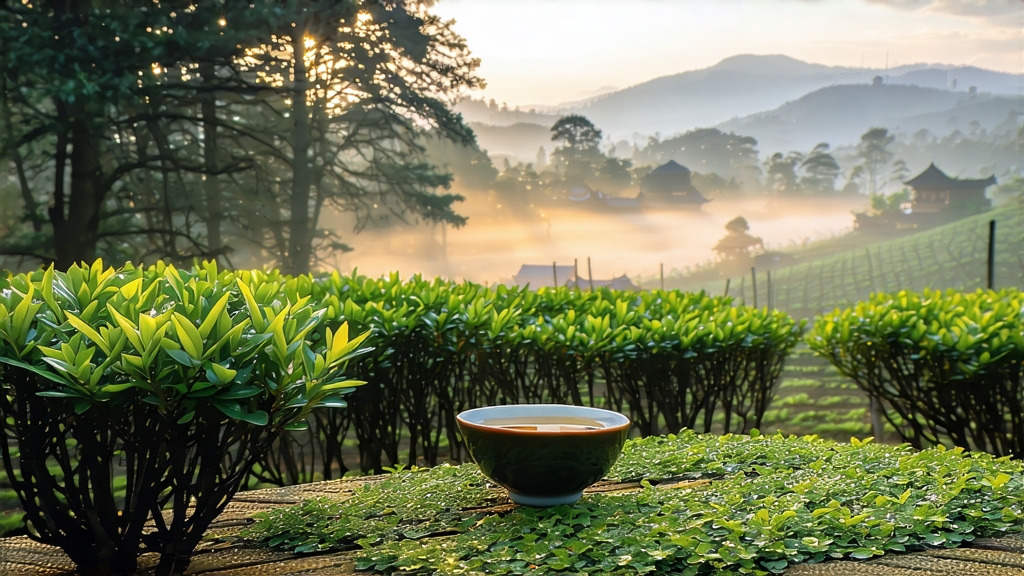
Floating above the Tropic of Cancer, the Alishan mountain range rises like a green spine through south-central Taiwan. Between 1,000 and 1,400 metres, where morning clouds tangle with cedar and cypress, the tea gardens of Alishan High-Mountain Oolong cling to narrow terraces carved by generations of farmers. Internationally the name “Alishan” is often used as shorthand for any Taiwanese high-mountain oolong, yet true Alishan tea is bound by altitude, cultivar, and a craft refined since the 1970s, when tea growers from Fujian’s Anxi county migrated across the strait and re-imagined their Tieguanyin techniques in cooler air.
History and Terroir
Alishan’s tea story begins with the 19th-century camphor and timber trade. Han Chinese settlers noticed indigenous Tsou people chewing wild tea leaves for stamina, and by 1885 seedlings from Wuyi and Anxi were carried uphill. Commercial plantings remained small until 1973, when the Taiwanese Tea Research and Extension Station released the Qing Xin (TTES #12) cultivar specifically for elevations above 1,000 m. Qing Xin’s slow growth in the persistent fog concentrates amino acids, while twelve-hour diurnal swings lock in volatile aromatics. Volcanic shale soil, high in porphyritic minerals, drains quickly yet retains just enough moisture to stress the bushes, coaxing them into producing smaller, jade-coloured leaves whose cell walls are thick with flavour precursors.
Cultivar and Harvest Calendar
Although Jin Xuan (TTES #12) and Cui Yu (TTES #13) are sometimes planted lower on the slopes, authentic Alishan High-Mountain Oolong is almost exclusively Qing Xin. The bush buds in late March; the spring flush, picked around Qingming, is considered the most balanced, while the winter harvest in mid-October yields lighter, more floral cups. Each pluck follows the “open leaf” standard: three, occasionally four, mature leaves attached to a semi-woody stem. This raw material is crucial for the repeated rolling that shapes Alishan’s signature hemispherical “dragon ball” appearance.
Crafting the Clouds: Oxidation Between Green and Black
Within minutes of plucking, the leaves are spread on bamboo trays inside a high-ceilinged shed where mountain breezes lower their temperature to 18 °C. A 90-minute withering under infrared lamps follows, softening cells for the “shake-green” step. Here, 8–10 kg of leaves are loaded into a cylindrical bamboo tumbler that rotates at 18 rpm for 6–8 minutes, bruising edges just enough to release enzymes. This cycle—resting and tumbling—is repeated 18–22 times across six hours, nudging oxidation to 20–25 %, the lighter end of the oolong spectrum. Once the leaf rim turns chestnut and the centre remains jade, the batch is pan-fired at 230 °C for three minutes to arrest oxidation. A novel “cool-down” stage unique to Alishan follows: leaves are placed in a cedar-lined chamber where temperature drops to 5 °C for 30 minutes, locking in floral notes. Subsequent rolling is done in two phases—first a mechanical kneading that twists leaves, then a cloth-wrapped ball-rolling that lasts 45 minutes and creates the tight, glossy pellets. Finally, the tea is dried at 85 °C for two hours, reducing moisture to 3 %, and rested for 40 days so residual aromas marry.
Grades and Styles
Farmers classify Alishan oolong into four unofficial grades. “Dayuling” (above 2,000 m) is rare, harvested only in spring, and commands prices above USD 1,000 per kg. “Premium Alishan” (1,200–1,400 m) balances fragrance and body. “Standard Alishan” (1,000–1,200 m) offers milky sweetness at half the price. Finally, “Alishan Light” is baked an additional 30 minutes at 90 °C, yielding a toastier cup favoured in colder months. Regardless of grade, the leaf should unfurl into complete, serrated blades with a frog-skin lustre—an indicator of proper altitude and craft.
Water, Heat, and Rhythm: Brewing Alishan Gongfu Style
Alishan oolong is introverted; it reveals itself only when coaxed by fast, hot encounters. Begin with 6 g of